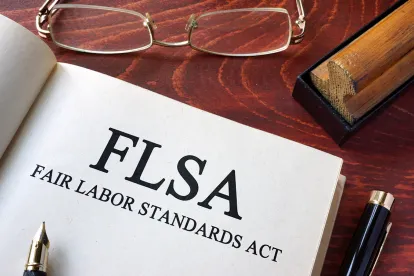Affirming an en banc decision of the U.S. Court of Appeals for the Fifth Circuit, the U.S. Supreme Court has held that an employer’s day-rate pay structure did not satisfy the “salary basis” component of the “white collar” executive exemption under the Fair Labor Standards Act (FLSA), even though the employee at issue earned more than $200,000 per year and unquestionably met the salary-level and duties requirements of that exemption. Helix Energy Sols. Group, Inc. v. Hewitt, 2023 U.S. LEXIS 944 (Feb. 22, 2023).
The FLSA’s “White Collar” Exemptions
Generally, the FLSA requires employers to pay covered employees at least the federal minimum wage for all hours worked and overtime pay at not less than one-and-one-half times their regular rate of pay for all hours worked over 40 in a workweek. Not all employees, of course, are eligible for overtime pay. For example, individuals who satisfy the requirements of the executive, administrative, or professional employee exemptions (often referred to as the EAP, or “white collar,” exemptions) are exempt from receiving overtime.
To qualify for these exemptions, Department of Labor (DOL) regulations provide that employers must satisfy three requirements: (1) the employee must be paid on a “salary basis”; (2) the employee’s salary must be at least $684 per week ($455 per week at the time of the plaintiff’s employment in the case at issue); and (3) the employee must perform the required duties associated with the exemption. A variation of these exemptions, known as the “highly compensated employee,” or HCE exemption, relaxes the duties requirements for employees who (at the time of the plaintiff’s employment) receive at least $100,000 per year in total compensation (now $107,432), but retains the same salary-basis and minimum salary-level requirements.
Under the FLSA regulations (29 C.F.R. § 541.602(a)), being paid on a “salary basis” means that an employee regularly receives a predetermined amount of compensation each pay period on a weekly, or less frequent, basis that is not reduced because of variations in the quality or quantity of the employee’s work. In this respect, “an exempt employee must receive the full salary for any week in which the employee performs any work without regard to the number of days or hours worked. Exempt employees need not be paid for any workweek in which they perform no work.” Id. § 602(a)(1).
The Lawsuit
Between 2014 and 2017, the plaintiff worked month-long periods or “hitches” as a supervisor on an oil rig and was paid $963 for every day that he worked. After his employment ended, he filed a lawsuit against the company, alleging that he was improperly classified as an exempt employee and therefore, was entitled to overtime pay. The parties conceded that, because the plaintiff was guaranteed a minimum of $963 per day for any week in which he worked (and, in fact, earned over $200,000 per year), he easily satisfied the salary level requirement of the EAP exemptions. Moreover, because he regularly supervised 10-12 employees, he satisfied the duties requirement of the executive exemption. Thus, the only dispute was whether the plaintiff’s daily-rate pay met the “salary basis” requirement of the exemption.
The FLSA regulations provide circumstances under which an exempt employee may receive additional pay for work (29 C.F.R. § 541.604(a)) or pay computed on a daily basis (29 C.F.R. § 541.604(b)) and still satisfy the salary-basis requirement. With respect to employees whose earnings are computed on a daily basis (at issue before the Court), the employee must be guaranteed a weekly minimum paid on a salary basis and the guaranteed weekly salary must bear a “reasonable relationship” to the total amount of pay received.
In this case, it was disputed whether this alternative method of satisfying the salary basis test applies to employees, like the plaintiff, who are highly compensated. However, the company conceded that the reasonable-relationship test was not met under Section 604(b) and, therefore, that alternative method was not at issue. Instead, the only issue was whether an employee paid a sufficiently high daily rate — that itself ensures they earn more than the minimum required weekly salary amount — satisfies the “salary basis” requirement of Section 602(a). Reversing the trial court, the Fifth Circuit Court of Appeals held that the salary-basis requirement was not met and therefore, the plaintiff was entitled to overtime pay.
The Supreme Court Majority Decision
In a 6-3 decision authored by Justice Elena Kagan, the Court affirmed the decision of the Fifth Circuit, concluding that the day-rate basis on which the plaintiff was paid did not satisfy the regulatory salary-basis requirement of the EAP exemptions. Teeing up “[t]he critical question [as] whether [the plaintiff] was paid on a salary basis under [29 C.F.R. § 541.602(a) of the DOL] regulations,” the majority wrote:
That section applies solely to employees paid by the week (or longer); it is not met when an employer pays an employee by the day, as [the company] paid [the plaintiff]. Daily-rate workers, of whatever income level, are paid on a salary basis only through the test set out in § 604(b) (which, again, [the company’s] payment scheme did not satisfy). Those conclusions follow from both the text and the structure of the regulations. And [the company’s] various policy claims cannot justify departing from what the rules say.
Because the plaintiff was paid every two weeks, and because that pay always exceeded the (then) $455 minimum salary threshold for any week in which he worked at all, the company argued that the salary-basis test was met. “But that interpretation,” the majority wrote, “is not the most natural one.” Rather, “[a]n employee paid on an hourly basis is paid by the hour, an employee paid on a daily basis is paid by the day, and an employee paid on a weekly basis is paid by the week — irrespective of when or how often his employer actually doles out the money.”
The Court also rejected the company’s argument that Section 604(b) does not apply because the HCE variation of the exemption was met. On the contrary, explained the majority, because the HCE variation likewise incorporates the requirement that an employee be paid on a salary basis, and both Sections 602(a) and 604(b) are different paths to satisfy that requirement, there is no reason to exclude Section 604(b) from the HCE analysis.
The Dissenting Opinions
In dissent, Justice Neil Gorsuch concluded that the case should be dismissed as improvidently granted because the Court was resolving an issue — application of Section 602(a) — that was different than the question for which the Court granted certiorari, that is, whether a highly compensated employee is covered by Section 604(b). Instead, Justice Gorsuch noted, the Court resolved the case by requiring a highly compensated employee to satisfy Section 602(a)’s salary basis requirement — “a question we never granted certiorari to decide, one on which we have received little briefing, and one [the employer] even assured us we need not decide.”
Justice Brett Kavanaugh filed a separate dissenting opinion, in which Justice Samuel Alito joined, and concluded that the requirements of the executive exemption had been met. In Justice Kavanaugh’s opinion, because “[the plaintiff’s] daily ‘predetermined’ rate ($963 per day) was higher than the weekly minimum requirement of $455 per week specified in the regulations[,]” he was “by definition [] guaranteed at least $455 for any week that he works” and thus, was paid on a salary basis. Justice Kavanaugh noted the majority’s decision “boils down to the head-scratching assertion that [the plaintiff] was somehow not guaranteed to receive at least $455 for any week that he worked even though (as all agree) he was in fact guaranteed to receive $963 for any day that he worked.”
A Larger Issue Lurking: Whether Salary-Level and Salary-Basis Requirements Are Themselves Valid
The Court’s conclusion (that the plaintiff was not paid on a “salary basis”) presumes that the FLSA itself requires employees to be paid on a salary basis or at a minimum salary level. The statute, however, does not specifically require either. It instead mandates only that an individual be employed in a “bona fide” executive, administrative, or professional “capacity,” i.e., perform the duties of such a position. The salary-level and salary-basis requirements, on the other hand, were imposed by DOL regulations.
Justice Kavanaugh (who expressed doubt at oral argument that those requirements are consistent with the statute) further expounded upon that issue in his dissent, stating, “[I]t is questionable whether the Department’s regulations — which look not only at an employee’s duties but also at how much an employee is paid and how an employee is paid — will survive if and when the regulations are challenged as inconsistent with the Act.” Justice Kavanaugh noted that the majority opinion did not address this antecedent question, as it concededly was not presented for review, and left this parting shot: “[W]hether in [the plaintiff’s] case on remand or in another case, the statutory question remains open for future resolution in the lower courts and perhaps ultimately in this Court.”






 />i
/>i

